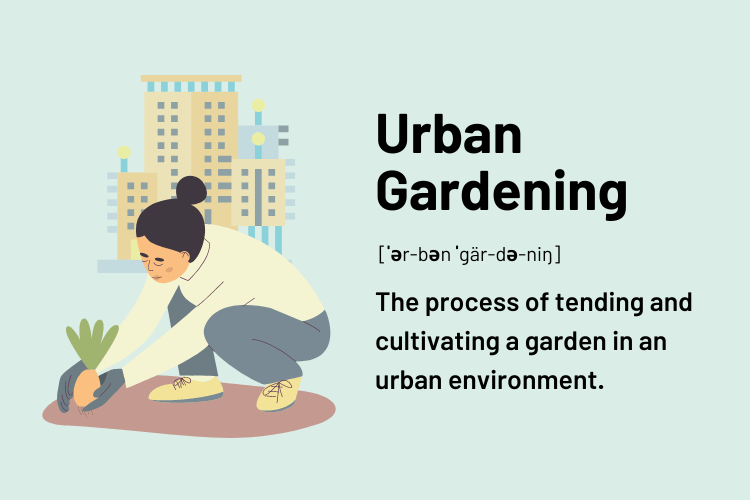8 Easy Facts About City Blooming Described
Table of ContentsThe 7-Second Trick For City BloomingFacts About City Blooming RevealedThe Ultimate Guide To City BloomingCity Blooming - TruthsGetting My City Blooming To Work
Nature has unbelievable effects on our physical and psychological health, so it's no surprise that a straightforward delicious on a desktop or some potted natural herbs on a windowsill can immediately boost an area. Take those plants a step even more, and you'll cross right into the area of metropolitan horticulture, which brings a lot more advantages to people and communities alike.What Are Urban Gardens?Urban gardening, often referred to ascity gardening, is defined as "the process of growing environment-friendly areas in metropolitan setups. "It encompasses a variety of jobs from city farming to patio area yards to neighborhood yards - fruit and vegtables. Urban gardens can be often tended by individuals, teams, firms, or companies. The amount and range of food grown can differ extensively, as well as the dimension of the project itself, however metropolitan gardening campaigns are all rooted in a city setup.
Whether they contain a collection of pots on a veranda or a cluster of stories on an uninhabited great deal, these gardens give even more than food, providing a host of ecological, financial, and social benefits. Due to the fact that fruit and vegetables is grown in neighborhood settings as opposed to far-away ranches, urban horticulture decreases transport requirements, consequently minimizing carbon exhausts.
Some Of City Blooming
Sustainable and natural farming gets rid of or lowers much of the ecological injury that would be incurred by commercial farming methods. Eco-friendly rooms in cities help in reducing the city heat island impact. Urban farming boosts local economic climates and sustains local food producers. Neighborhood horticulture tasks typically use food at little or no charge, which helps reinforce food budget plans and raise food security. Urban yards can be tools of social modification that address injustices, systemic bigotry, and area advancement issues. Here at Hunger For Adjustment, we use food as a tool to develop wellness, wide range, and social adjustment in North Minneapolis. We bring people with each other to learn, cook, eat, and grow food, creating change that lasts.
With each other, we can create well-rooted and flourishing change!.

The primary lesson we, once more, need to discover is that cities are not divorced from nature. They are a part of the bigger biome in which they're situated. As organizers and designers, we are trained to assume holistically. While these disciplines advertise cities as valuable, no city is best not even close, and the susceptabilities and affiliations of the worldwide supply chain has influenced everyone in unforeseen means.
City Blooming Fundamentals Explained
I will certainly consider designs from the past that advertised city yards and garden enthusiasts, and show what worked and what did not. I will discuss the opportunities and difficulties of being a metropolitan garden enthusiast, what is required to establish a garden of your own, and what legislations and standards stand in the means of making cities much better at promoting urban yards.
The quantity of time threw away obtaining to and from typical offices has been well documented. One notable research ended that before the pandemic, Americans squandered approximately 54 hours a year travelling. The accumulated negative impacts of pollution and stress that arise from commuting alone by auto as the majority of Americans do are considerable.
The capacity to come to the workplace for collaboration and society, and remain home for focused work is a concept that conserves time, is much better for the atmosphere and is a smarter usage of restricted sources. What hasn't yet taken hold is the connection between these adjustments in behaviors and exactly how cities can respond.
Unknown Facts About City Blooming
What are Full Report the health effects of our cities unexpectedly overdesigned for cars? How can our city facilities (roads, utilities) do far better, not just as avenues to relocate individuals and items, yet as factors to all-natural systems? Urban sensations such as smoke, inadequate water top quality and the 'warmth island result' can be minimized by greening our roads, energizing our lorries and growing our car park.
In a recent article in the Wall surface Road Journal, Richard Florida reviewed the sensation of 'zoom cities,' which draw in remote workers by creating a picture of a higher quality of life (fruit and vegtables). He wrote: "For cities, remote job changes the focus from luring business with special bargains to tempting skill with services and amenities
Urban horticulture currently has numerous options to aid you expand food anywhere you have space, such as with container horticulture, hydroponic gardening, and roof horticulture. This implies you can control the area where you grow the food, and stress much less about ecological conditions like drought or winter. You can select what you want to expand, exactly how you desire to expand it, and where you intend to expand.
What Does City Blooming Do?
Growing mass-produced food with conventional farming techniques takes a whole lot out of the planet. Past the numerous resources that are utilized on the ranch, the food then has to be carried from where it is grown to a store near you. That needs burning a great deal of fuel. On average in the U.S., food is now transferred between 1,500 and 2,500 miles to reach the customer.
